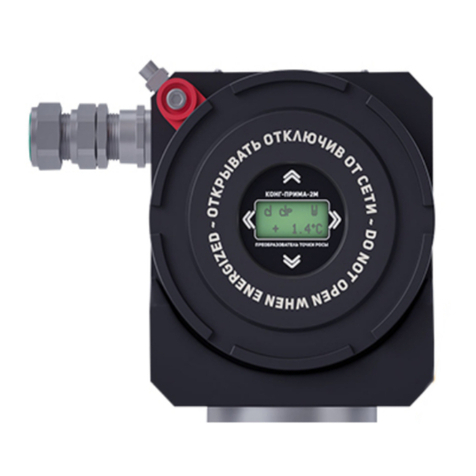=11>?@34@=AB& & CD&@,E"%&+FG+"HE.,#
=11>?@34@=AB& & 6D&I%F"#&J.++,+&/$+G"HF&$#KF+&
/.KF&%.*LE.#*&
=11>?@34@=AB& & MD&I%F"#&J.++,+&/$+G"HF&$#KF+&
J.H+,/H,NF&O-F+E.H"%P&%.*LE.#*&
=11>?@34@=AB& & 9D&?H"EEF+.#*&,G&%.*LE&+")/&K$F&
E,&Q"EF+&H,#KF#/"E.,#&
1.3. MEASUREMENT PRINCIPLE
The Hygrovision BL is a compact, portable analyzer used for tak-
ing automatic and manual measurements of the dew point tem-
perature of water and/or hydrocarbons.
This portable chilled-mirror automatic hygrometer operates ac-
cording to the principle of direct measurement and employs a
temperature-controlled mirror to establish the dew point. During
the measurement process the reflectivity of the mirror is meas-
ured. As the temperature of the mirror is lowered, its reflectivity
begins to go down when the dew point is reached and condensa-
tion begins to form. In this process condensates are deposited on
the mirror (reflective surface).
A special system uses optical properties to register the formation
of this condensate film.
This system utilizes the phenomenon of total refraction to register
dew point.
A laser emitting vertically polarized light illuminates the interface
of a heterogeneous media (gas) 1 and a reflective dielectric sur-
face (temperature controlled mirror) 2 at a specific angle. This
angle is known as Brewster’s Angle.
When the dew point mirror (dielectric surface) is clean, in other
words, when no condensate has formed, the polarized light rays
falling on the interface between the gas and the mirror’s surface
are completely refracted. As a result no light is reflected onto ei-
ther of the photo detectors (F1 and F2). This results in a null sig-
nal from the sensors (ILLUSTRATION 1). With the microscope
attached, total refraction can be observed visually under both side
lighting and vertical lighting. Under side lighting*, the surface of
the dielectric mirror appears black (illustration 2). Under micro-
scope (vertical) lighting the mirror’s surface appears light blue
(ILLUSTRATION 3).
*Please note: the side-lighting unit and the laser are not the same
component.
In the case of water vapor, as the temperature of the mirror is
lowered and condensation droplets begin to form, the angle at
which the polarized light strikes the surface changes with the re-
sult that refraction no longer occurs. Instead, the light rays are
reflected and scattered. The photoelectric registration system re-
cords an increase in the intensity of the light detected by the
photo detector located in position F1(ILLUSTRATION 4). The
signal intensity (aka signal level) is dependent on the amount of
water condensation.
Under side lighting, water condensation appears in the form of an
accumulation of luminous, somewhat similarly sized red droplets





























